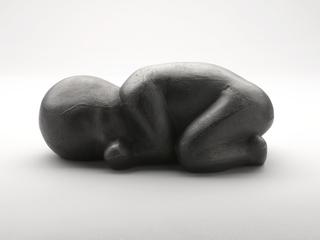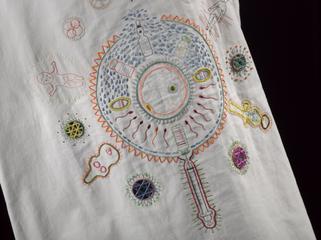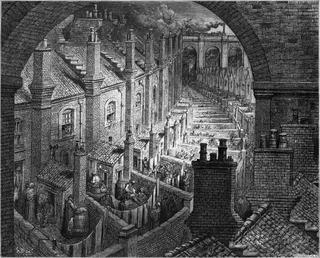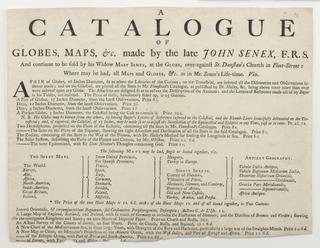
3-dimensional bug pattern by Donald Robbins
'3-dimensional bug pattern' lithograph by Donald Robbins in the USA, 1968, published in London by Motif Editions. The portrait composition features a checkerboard of cubes with swirling patterned sides, in dark blue.
From a set of seven lithographs by different artists published to accompany the exhibition Cybernetic Serendipity at the Institute of Contemporary Art (ICA) in London in 1968. Motif editions produced the set to sell to visitors at the ICA, and when the exhibition toured to the USA. It was intended to highlight some of the most interesting and iconic paper-based works in the show. The portfolio of lithographs includes works by the Computer Technique Group, Charles Csuri and James Shaffer, William Fetter, Maughan S. Mason, Donald K. Robbins and Kerry Strand. The artists used various systems and technologies to produce them, often relying on large-scale military equipment.
The book jacket described this lithograph by Robbins as a "3D computer design based upon the four-bug problem..." This is a mathematical challenge, in which four bugs at the corners of a square crawl clockwise at a constant rate, each moving directly towards its neighbour. At any instant the bugs form a square and, as they crawl towards one another, the square both decreases in size and rotates. With the use of cubes and perspective, Robbins has added a three-dimensional element to the "four-bug" image.
Cybernetic Serendipity, curated by Jasia Reichardt, was a seminal moment in the history of computer-generated art. It was the first international exhibition in the UK devoted to the relationship between the arts and new technology, featuring over 130 participants including composers, engineers, artists, mathematicians and poets.
Its aim was to present an area of activity which manifested artists' involvement with science, and scientists' involvement with the arts; particularly the links between the random systems employed by artists, composers and poets, and those involved with the making and use of cybernetic devices. It attracted national and international attention, and over 60,000 visitors at the ICA.
At the time of the original plotter drawing and lithograph, Robbins worked for the Sandia Corporation in Albuquerque, New Mexico. The Sandia National Laboratories were heavily involved in the development of nuclear weapon systems during and after World War Two. Early computer art was sometimes criticised for its reliance on these mainframe computer systems generally only available to the military and research institutions.
Some participants in Cybernetic Serendipity went on to found the Computer Art Society later in 1968, which still brings together computer artists in the UK.
Details
- Category:
- Art
- Object Number:
- 2019-404
- Materials:
- paper (fibre product) and ink
- Measurements:
-
overall: 754 mm x 506 mm
overall (lithograph only): 750 mm x 510 mm
- type:
- lithograph
- copyright:
- Robbins, Donald




